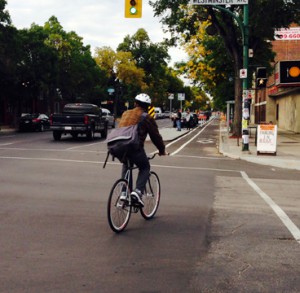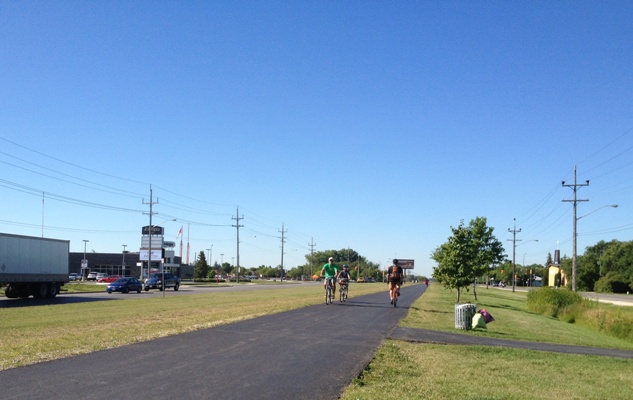If you’re like me and cannot resist reading the comments section on news websites (Is there a therapy for this addiction?), you have probably noticed that, each time a story goes up about cycling and infrastructure, inevitably a person or two will chime in with the argument “if they want to be on the roads, they should have a license!”
Let’s examine the idea of bicycle licenses from a variety of vantage points to gauge whether it is a worthwhile endeavour for Winnipeg.
Financial
People on bikes are freeloading on the infrastructure, they haven’t paid their fair share to use it.
 A common misunderstanding is that the funds paid to license a car pay for road repairs and upgrades, but this is not true. Infrastructure costs are paid through taxes (income, sales and property). Currently in the city of Winnipeg, 6.7% of the city’s Master Transportation Plan is being directed to projects for pedestrians and cyclists, while 9% of people currently walk or bike as the primary mode of their daily commute. By these numbers, people who bike are actually paying a higher share of the cost to commute than those who drive. Essentially, people who walk, bike or take transit are paying more than their fair share, while people who drive are actually being subsidized.
A common misunderstanding is that the funds paid to license a car pay for road repairs and upgrades, but this is not true. Infrastructure costs are paid through taxes (income, sales and property). Currently in the city of Winnipeg, 6.7% of the city’s Master Transportation Plan is being directed to projects for pedestrians and cyclists, while 9% of people currently walk or bike as the primary mode of their daily commute. By these numbers, people who bike are actually paying a higher share of the cost to commute than those who drive. Essentially, people who walk, bike or take transit are paying more than their fair share, while people who drive are actually being subsidized.
So, should licensing fees be used to fund active transportation strategies?
No, that is not reasonable. If all citizens pay tax, then it is unfair to force one demographic to fundraise for infrastructure expenses on top of their taxes, while others do not.
But, how much money are we talking about here?
Profitability
All of the cash made from the licensing could then pay for the bike lanes!
Cities that have imposed a licensing by-law have found that the cost to administer the program far surpassed the revenue generated. In Ottawa, for example, the city estimated that a Bike Licensing program would cost $100,000 to run, but would only generate $40,000 in fees.
Barriers
So, if the city were to introduce bike licensing at a rate that would make it profitable, what would the impact be on the number of individuals who choose to travel on their bike?
The larger question here is, should cities charge those who choose to bike a licensing fee high enough to make a profit, even if it means a number of individuals would choose another mode of transportation?
To answer this question, you need to consider the full cost of commuting, and what the individual pays for each commute vs what society pays. The folks at Moving Forward, a data analysis blog, calculated the cost of a commute in Metro Vancouver according to the various modes of transportation available. While the numbers are obviously specific to Vancouver, we can see that the societal cost of individuals who commute by car is far higher than the cost for those who commute via mass transit, walking or biking.
From this data, we can conclude that cities must encourage citizens to commute in healthy, active ways as opposed to creating barriers, like having to purchase a license.
Going back to the beginning of this article, I noted that 9% of Winnipeggers currently choose to bike or walk as their primary mode of transportation. However, an incredible 45% of citizens taking the same survey said they would walk or cycle more if safer infrastructure was available. That’s a huge number of people representing a significant reduction in societal costs in the long term for commuting.
Winnipeg is approaching a population of one million, so it is clear that the city must remove barriers preventing individuals from commuting in healthy ways, and should not put an unnecessary burden on those who are already contributing more than their fair share with each commute.
Safety
Bike licensing will make people who bike safer.
We’ve had a great debate about this here at Green Action Centre! When I asked my coworkers for their feedback, one point made was that it’s unsafe to send folks with no training out onto the roads on their bike.
We all agree that education is key, and that individuals who want to try commuting on their bicycle should take a skills workshop (you can find details through Bike Winnipeg), or travel the roads with an experienced cyclist to learn the rules and practice their skills.
But I think we need to go further. Safe biking workshops should also be part of the school curriculum, where children can be taught lifelong skills on how to travel safely on the roads. Check out this video from the cycling mecca, the Netherlands, on how they prepare school age children to join the traffic on the main roads. It’s important to note that hundreds of thousands of children cycle to school in the Netherlands each day, and many travel upwards of 15 kilometers each way. While cycling in Winnipeg is not ideal in the crux of winter, it’s important to note that our flat, prairie landscape makes Winnipeg an excellent cycling city. Just think of the health benefits of having thousands of kids commuting actively each day, as opposed to being dropped off in a car.
With improved infrastructure, skills workshops in primary school and improved education for adult riders, we can certainly make people who bike in Winnipeg safer. Do we need to have a licensing fee to make this happen? No, we don’t.
After examining the bike licensing issue from several angles, it does not appear to be a good use of time and resources on the part of the City of Winnipeg. Instead, we see that supporting active and healthy means of transportation for citizens in all corners of Winnipeg is the best and most cost effective way to ensure our city becomes a hub for modern, sustainable commuting.
Now, we just need to disseminate this information to all of those news commentators!





Just a heads up, the ‘cost of commute’ data exists for Winnipeg as well! It was put together for the ‘OurWinnipeg’ plan.
I don’t have the direct link now but it’s out there in a PDF somewhere. Unsurprisingly the results were similar.
Good to know – I will go hunting!!
The process for registering motorized vehicles is managed through the insurance industry. This is a process I full support, as a daily cyclist commuter, as part of the protection of my assets and future mobility.
Your last line is key – getting this information out to the 90% who mostly commute in vehicles – and in a way that helps reduce that stat! I think it would help if we could provide costs for Winnipeg rather than Vancouver. As a cyclist it would give me more ammunition in a debate with a vehicle commuter if I could quote just how much I am subsidizing his/her commute. I think it would hit home more.
Thanks Maureen – I agree! Having Winnipeg specific data would be excellent!
Thanks, a great article and good follow up comments. I would just add that people can mean several different things when they talk about bicycle/cyclist licenses: the bicycle itself can be licensed (which could conceivably be connected to insurance), the cyclist can pay a license for the right to ride on the street, and/or cyclists could be required to pass a cycling test in order to obtain a license allowing them to ride on the street. You have focused on the second of these ideas, but it would also be interesting to look at the question of requiring cyclists to pass a cycling exam. This would be done not for financial reasons but for safety.
Hi Jeremy – I agree! I’ve contacted one of our panelists from our Commuting With Kids event this past spring during Bike Week. He is the principle of a school that offers a Bike Course as part of their physical education program. Look forward to a future blog post about this from me!
It’s interesting that the goal of a phys ed program is to increase the health and wellness of kids, and to (hopefully!) introduce them to a lifetime of activity, but the programs don’t touch formally on ways to travel from point to point in healthy ways. Ensuring kids learn how to commute safely when walking and cycling will set them up for a healthy future.
It is true that motor vehicle licenses do not pay for road infrastructure, but they should be contributing to the cost.
There is special infrastructure built accommodate cyclists and it has to be maintained and cleared in the winter. It is only right that cyclists make some contribution to the cost as a matter of principle.
While it is true that the fees would have to be kept low so as not to discourage cyclists and that the cost of administering the program might be greater than the money recovered, there is one benefit that would come from licensing.
It would make it much easier to track and recover stolen bicycles.
Thanks Carolyn,
I’ve been trying to find examples in other cities of bike licensing programs in other cities being successful, even at things like recovering stolen bikes. It seems logical in theory, but in practice the cost is just too high to make it worth it it seems.
In theory it also seems like users should have to contribute to the cost of infrastructure. But, again, drilling down and considering that taxes pay for infrastructure, it seems we are all paying, but we’re all getting different levels of service.
Green Action Centre has advocated for an increase to the gas tax as a means to level the balance. You can read a recent Op Ed piece published in the Winnipeg Free Press here: https://greenactioncentre.ca/living-green-living-well/a-new-deal-for-winnipeg-and-transportation/
While it’s true that people on bikes would be exempt from a gas tax, I would ask: is that a problem? I think that if there are more perks for those who choose to walk and cycle, over those who choose to commute in a car, that’s a good thing overall. If it makes people think twice before reaching for the car keys, that’s a win for everyone!
Great article! Though biking may not be ideal in the crux of Winnipeg’s winter, it shouldn’t be discouraged. More and more cyclists are choosing to brave the cold and bicycle in winter time. Barriers exist, such as delayed snow removal and, obviously, the lack of bicycle infrastructure, but these can be overcome with proper management. I’ve read that Stockholm city council deemed ploughing streets before bicycle paths as sexist because more women bike to work in the winter than men. It may not be the case in Winnipeg, but why should cyclists be treated as second class citizens?
Graham – thanks for letting me know about the Stockholm city council. I didn’t know that, but will do a bit of research to find the details. Very interesting!
I find that it’s not so much being treated as second class, it’s that consideration to the fact that people commute in many ways isn’t thought about in our never-ending street repair cycle. If the city is ripping up a street, that is the time to introduce protected bike lanes and other features. It should just be part of the planning process. For example, where the painted bike lane ends on McDermot (heading East, when you cross over Princess), the sidewalks and roads were completely ripped up this summer and construction is just finishing. But no improvement to the “disappearing bike lane” have been done, so people on bikes will continue to be squeezed into motor traffic through this section before the painted bike lane reappears East of Main Street. Disappointing.
Well done Green Action Centre. People need to understand this issue as it is entirely misunderstood by people that drive, people that walk and people that ride alike. The costs of administering a system of bike licensing is clearly an issue (why do you think that we don’t have them anymore). Education of both drivers and people who ride bikes is a missing link in my opinion. New drivers receive little in terms of education related to interacting with bikes and there is no formal education for riding bikes. It is time that Manitoba Education got on board with educating our youth on bicycle skills so that they can become better riders and drivers. Changing the habits of the existing drivers is not easy but has to be considered as well.
Thanks Dave! Yes, I should have mentioned the education of drives more in the blog post. While also teaching kids on bikes the rules of the road, you can see in the video example that kids also take turns being “drivers” and “pedestrians”, to get a sense of how the whole network works together. When we held our Commuting With Kids panel during Bike Week, panelist Nathan Wilde mentioned how his oldest son is turning 16 this year, and how he’s already confident in his son’s skills as a driver as he’s had so many years learning and following the rules of the road on his bike. He understands signage, signaling and the importance of people on bikes and people in cars respecting each other.
As for existing drivers, I agree. The lack of knowledge is apparent every time I’m out cycling, signalling a right turn and getting a wave in response. I always follow-up that right turn signal with a clear “I’m going this way” point! But, I’ll take the wave hello over an angry honk anytime!